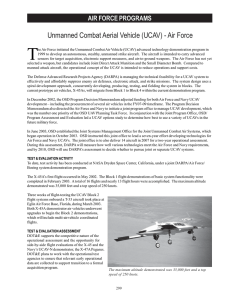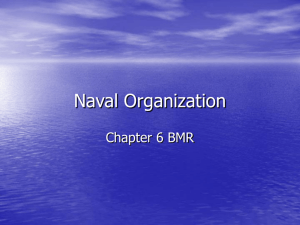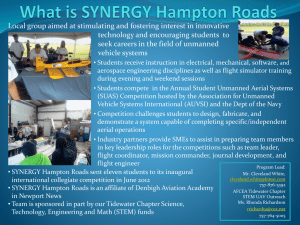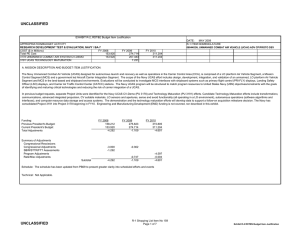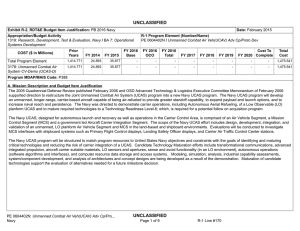T Unmanned Combat Aerial Vehicle - Navy NAVY PROGRAMS
advertisement
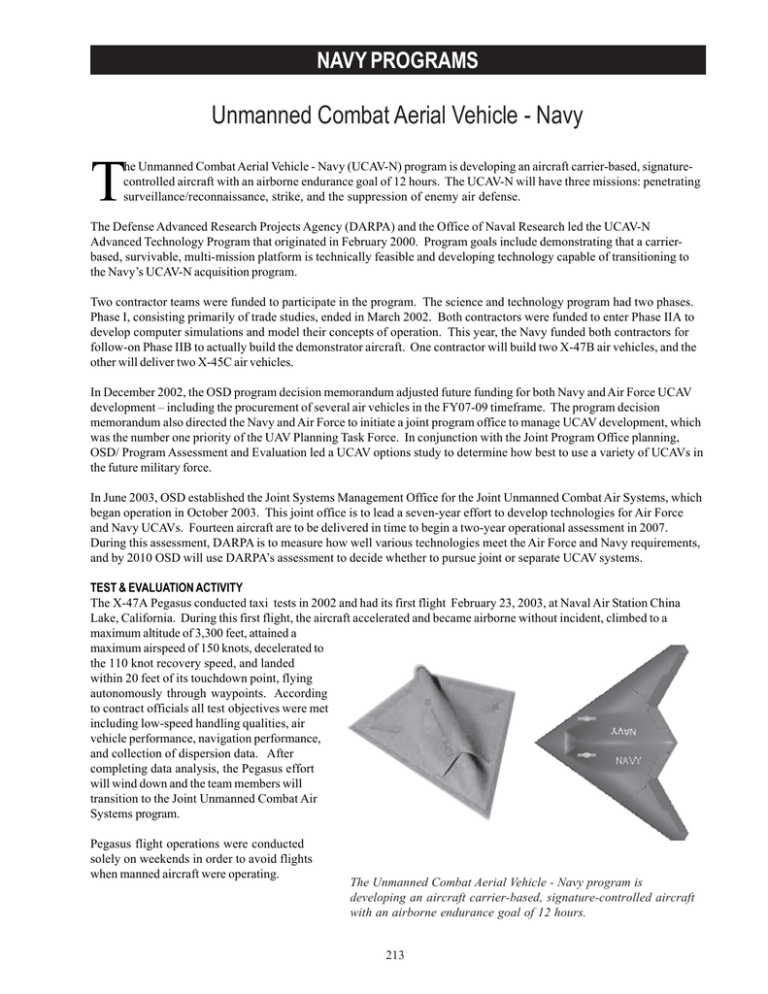
NAVY PROGRAMS Unmanned Combat Aerial Vehicle - Navy T he Unmanned Combat Aerial Vehicle - Navy (UCAV-N) program is developing an aircraft carrier-based, signaturecontrolled aircraft with an airborne endurance goal of 12 hours. The UCAV-N will have three missions: penetrating surveillance/reconnaissance, strike, and the suppression of enemy air defense. The Defense Advanced Research Projects Agency (DARPA) and the Office of Naval Research led the UCAV-N Advanced Technology Program that originated in February 2000. Program goals include demonstrating that a carrierbased, survivable, multi-mission platform is technically feasible and developing technology capable of transitioning to the Navy’s UCAV-N acquisition program. Two contractor teams were funded to participate in the program. The science and technology program had two phases. Phase I, consisting primarily of trade studies, ended in March 2002. Both contractors were funded to enter Phase IIA to develop computer simulations and model their concepts of operation. This year, the Navy funded both contractors for follow-on Phase IIB to actually build the demonstrator aircraft. One contractor will build two X-47B air vehicles, and the other will deliver two X-45C air vehicles. In December 2002, the OSD program decision memorandum adjusted future funding for both Navy and Air Force UCAV development – including the procurement of several air vehicles in the FY07-09 timeframe. The program decision memorandum also directed the Navy and Air Force to initiate a joint program office to manage UCAV development, which was the number one priority of the UAV Planning Task Force. In conjunction with the Joint Program Office planning, OSD/ Program Assessment and Evaluation led a UCAV options study to determine how best to use a variety of UCAVs in the future military force. In June 2003, OSD established the Joint Systems Management Office for the Joint Unmanned Combat Air Systems, which began operation in October 2003. This joint office is to lead a seven-year effort to develop technologies for Air Force and Navy UCAVs. Fourteen aircraft are to be delivered in time to begin a two-year operational assessment in 2007. During this assessment, DARPA is to measure how well various technologies meet the Air Force and Navy requirements, and by 2010 OSD will use DARPA’s assessment to decide whether to pursue joint or separate UCAV systems. TEST & EVALUATION ACTIVITY The X-47A Pegasus conducted taxi tests in 2002 and had its first flight February 23, 2003, at Naval Air Station China Lake, California. During this first flight, the aircraft accelerated and became airborne without incident, climbed to a maximum altitude of 3,300 feet, attained a maximum airspeed of 150 knots, decelerated to the 110 knot recovery speed, and landed within 20 feet of its touchdown point, flying autonomously through waypoints. According to contract officials all test objectives were met including low-speed handling qualities, air vehicle performance, navigation performance, and collection of dispersion data. After completing data analysis, the Pegasus effort will wind down and the team members will transition to the Joint Unmanned Combat Air Systems program. Pegasus flight operations were conducted solely on weekends in order to avoid flights when manned aircraft were operating. The Unmanned Combat Aerial Vehicle - Navy program is developing an aircraft carrier-based, signature-controlled aircraft with an airborne endurance goal of 12 hours. 213 NAVY PROGRAMS TEST & EVALUATION ASSESSMENT DOT&E supports the competitive nature of the operational assessment and the opportunity for side-by-side flight evaluations of the X-45 and X-47. DOT&E plans to work with the operational test agencies to ensure that relevant early operational data are collected to support transition to a formal acquisition program. The inability to mix manned and unmanned flight operations in controlled airspace could be a significant hurdle during UCAV development and severely restricts the number of test flight days available to UCAV developers. 214
